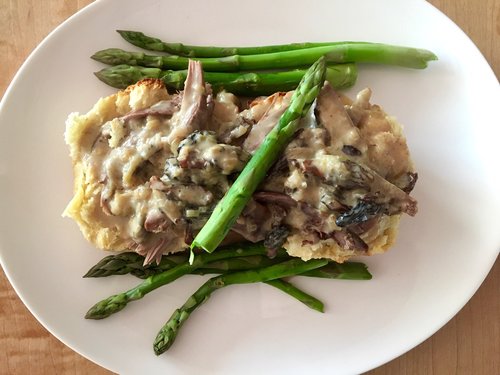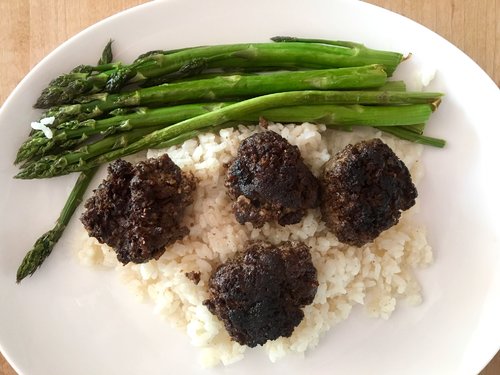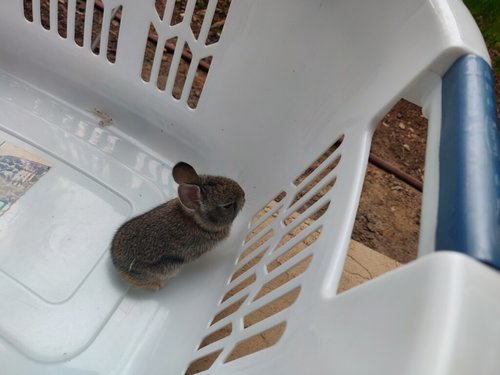RG_Adult_Onset_Hunter
Well-known member
Almost every time I tell someone that I am craving jackrabbit I am met with an expression of incredulous disgust. This look says, “jackrabbit is not meant for human consumption; furthermore, you should probably go to the hospital to make sure you did not catch something”. I’m OK with people thinking that I am a little touched in the head, but it does bother me that people think that jackrabbit is revolting table fare.
I hunt a particular property each year for turkey and perhaps one day a bear. The layout of the property while immense, can make it a tactically demanding place to hunt. I only recently realized that I have never killed a big beard dragger there. A year or two ago, after a failed setup for turkey, I made the decision to stalk a jackrabbit that I had seen on the edge of an alfalfa field about 200 yards away. This stalk took about an hour and a half, and about a half a mile of terrain to hide my approach. I am certain that most people would think I was insane for going after my first jack that way as opposed to just jump shooting it (especially for an animal that some would say is not fit for dog food). But I wanted to get an animal that was totally unaware of the threat.
When I hefted this impressive animal, I immediately knew it was worth the effort. Jacks are way bigger than you ever think they will be. My home state has no closed season on them and no bag limit, but I have a personal cap of 3 a day, because taking more than that seems greedy. The meat has the mahogany color of venison, which brings me to rule number one for cooking jackrabbit.
Jackrabbit is not a chicken, it’s not even a rabbit.
Jackrabbits are hares. I have seen several cookbooks make the mistake of saying that what works for chickens works for rabbits. They then continue to lump jackrabbits into the “fry it like a chicken” group. Unless the recipe is an old-school one that specifies hare, I’d ignore what most cookbooks have to say. Imagine if you took the front shoulder of a deer and cooked it using a standard recipe for chicken, do you think it would come out tasting great, or do you think it would be tougher than your shotgun sling? This brings us to our next rule.
Cook it low and slow.
Take that same deer shoulder and cook it at low temp for a long time. Suddenly all that connective tissue becomes delicious silky goodness. This transformation can’t be rushed. Jackrabbits know that everything wants to kill and eat them. Their defense to this to be ready to bolt at an instants notice. You can practically taste that tension in their muscles. Low heat over a long time (preferably in a moist environment) relaxes that tension in a way that nothing else can. The flavor of a jackrabbit is mild and dark, I’m certain that most people’s bad experiences with jacks is because the meat gets dried out and chewy from being cooked too fast in a dry environment. It’s a hard-working critter that does not have a scrap of fat on them, it’s not a stockyard cow or pig. This brings me to the next rule.
Add Fat
As a chef, I love messing around with jackrabbit because it gives me the freedom to make things that would otherwise be overpoweringly rich. Jackrabbit has ZERO fat on it, which does not mean it should be poorly regarded, it just means you get to control how much fat goes into it. Any fat works: olive oil for slow simmered soups; pork-fat for sausage (jackrabbit makes great chorizo and better merguez); butter for just about any other prep. The point is, you need some fat in the mix to balance the flavor and to help prevent it from drying out.
Recently I killed three jacks on a rainy April day, the rain concentrated them in the small sections of dry briar. Had I decided to break my limit, I would have depleted my ammo before I ran out of jacks. Looking at the meat in my freezer, I can’t help but fantasize about soups, tagines, sloppy joes, biscuits and gravy, souffle, street tacos, and merguez. I’m certain I’ll run out of meat before I run out of good recipes for this high-quality animal.

Braised Jackrabbit thigh in Morel Gravy on fresh southern biscuit. The asparagus let's you know it's spring.

Braised Jackrabbit Merguez meatballs over rice...and yeah asparagus again (my peas crapped out this year).
I hunt a particular property each year for turkey and perhaps one day a bear. The layout of the property while immense, can make it a tactically demanding place to hunt. I only recently realized that I have never killed a big beard dragger there. A year or two ago, after a failed setup for turkey, I made the decision to stalk a jackrabbit that I had seen on the edge of an alfalfa field about 200 yards away. This stalk took about an hour and a half, and about a half a mile of terrain to hide my approach. I am certain that most people would think I was insane for going after my first jack that way as opposed to just jump shooting it (especially for an animal that some would say is not fit for dog food). But I wanted to get an animal that was totally unaware of the threat.
When I hefted this impressive animal, I immediately knew it was worth the effort. Jacks are way bigger than you ever think they will be. My home state has no closed season on them and no bag limit, but I have a personal cap of 3 a day, because taking more than that seems greedy. The meat has the mahogany color of venison, which brings me to rule number one for cooking jackrabbit.
Jackrabbit is not a chicken, it’s not even a rabbit.
Jackrabbits are hares. I have seen several cookbooks make the mistake of saying that what works for chickens works for rabbits. They then continue to lump jackrabbits into the “fry it like a chicken” group. Unless the recipe is an old-school one that specifies hare, I’d ignore what most cookbooks have to say. Imagine if you took the front shoulder of a deer and cooked it using a standard recipe for chicken, do you think it would come out tasting great, or do you think it would be tougher than your shotgun sling? This brings us to our next rule.
Cook it low and slow.
Take that same deer shoulder and cook it at low temp for a long time. Suddenly all that connective tissue becomes delicious silky goodness. This transformation can’t be rushed. Jackrabbits know that everything wants to kill and eat them. Their defense to this to be ready to bolt at an instants notice. You can practically taste that tension in their muscles. Low heat over a long time (preferably in a moist environment) relaxes that tension in a way that nothing else can. The flavor of a jackrabbit is mild and dark, I’m certain that most people’s bad experiences with jacks is because the meat gets dried out and chewy from being cooked too fast in a dry environment. It’s a hard-working critter that does not have a scrap of fat on them, it’s not a stockyard cow or pig. This brings me to the next rule.
Add Fat
As a chef, I love messing around with jackrabbit because it gives me the freedom to make things that would otherwise be overpoweringly rich. Jackrabbit has ZERO fat on it, which does not mean it should be poorly regarded, it just means you get to control how much fat goes into it. Any fat works: olive oil for slow simmered soups; pork-fat for sausage (jackrabbit makes great chorizo and better merguez); butter for just about any other prep. The point is, you need some fat in the mix to balance the flavor and to help prevent it from drying out.
Recently I killed three jacks on a rainy April day, the rain concentrated them in the small sections of dry briar. Had I decided to break my limit, I would have depleted my ammo before I ran out of jacks. Looking at the meat in my freezer, I can’t help but fantasize about soups, tagines, sloppy joes, biscuits and gravy, souffle, street tacos, and merguez. I’m certain I’ll run out of meat before I run out of good recipes for this high-quality animal.

Braised Jackrabbit thigh in Morel Gravy on fresh southern biscuit. The asparagus let's you know it's spring.

Braised Jackrabbit Merguez meatballs over rice...and yeah asparagus again (my peas crapped out this year).






